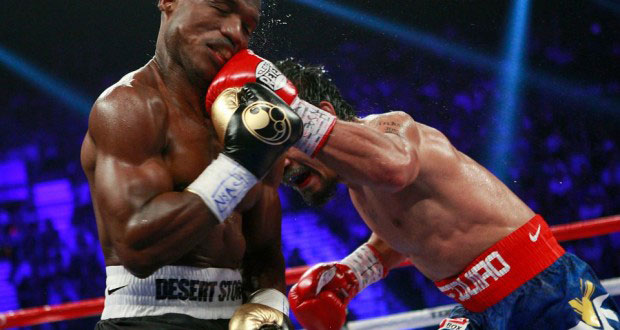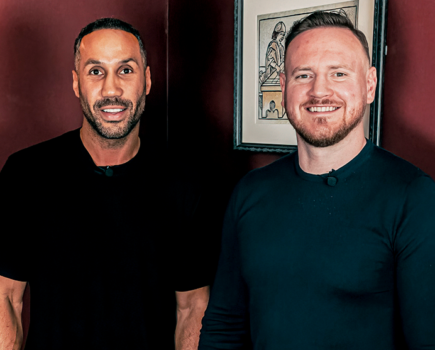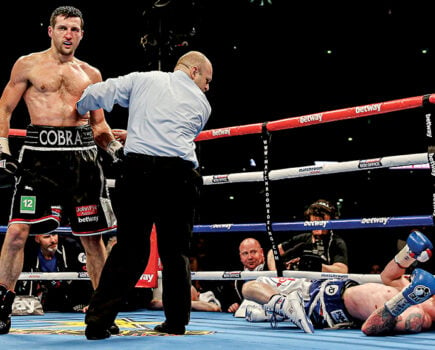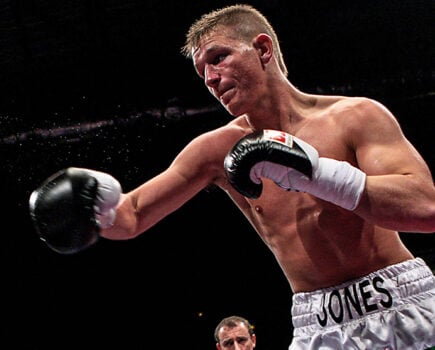“EVERYBODY wants stats because they tell a story in all sports.”
Bob Canobbio’s observation is simple and straightforward, yet it has nonetheless formed the basis of a system which has become a fundamental component in boxing telecasts in the USA and around the globe.
In essence, CompuBox is a computerised program designed to count the number of punches thrown and landed during a boxing match. Two operators sit ringside with laptops, each focusing on the actions of a designated fighter. When fighter A throws a punch, operator A enters this into the system. The same goes for fighter B and operator B.
“It’s pretty uncomplicated,” CompuBox owner Canobbio admits. “We have keys for jabs connected, jabs missed, power punches connected and power punches missed. For lack of a better description, we consider any non-jab a power punch.
“When you add together the jabs and non-jabs, this produces the statistic for the total punches thrown. From this, we’re able to generate different percentages. For example, fighter A landed 40 per cent of his power punches, but only 20 per cent of his jabs.”
By keeping the keys basic, Canobbio ensures the stats generated by the system are as accurate as possible. “In the early days of CompuBox, we tried experimenting with head and body shots, left and right hand, hook and uppercut, but there were just too many keys. Simplicity equals accuracy.”
Established in 1985, the inspiration for CompuBox originated from a computer-generated tennis statistics program. Different shots were recorded on a portable computer at the venue. This concept planted a seed in the minds of Canobbio and his then-business partner Logan Hobson, who co-founded CompuBox before leaving the New York-based company in 2002.
“As boxing lovers, Logan and I saw the tennis program and immediately wondered whether we could transfer the model to boxing,” Bob recalls. “It really all began with the advent of portable computers, which allowed us to log the punches from ringside. Once we had the program written, we were on our way.”
After testing the system at some regional shows, Canobbio pitched the idea to Ross Greenburg, who would become president of HBO Sports but at that time was an executive producer at the organisation. Greenburg was impressed with the design and a deal with HBO subsequently followed.
“It all happened rather quickly,” Canobbio remembers. “Ross liked what he saw, so we were in business. The first fight we ever covered was on February 16, 1985 in Reno, Nevada. It was the WBA lightweight title bout between Livingstone Bramble and Ray Mancini. It was an interesting debut to say the least. Mancini was a punching machine, so we had our work cut out. He was very busy, throwing over 100 punches per round, whereas Bramble was more of a counter-puncher. Mancini threw roughly 500-600 more punches, but Bramble landed more because he countered so well.”
The frenetic and fast-paced action exhibited by tireless boxers like Mancini demands highly skilled operators to collect the punch data accurately. Prospective CompuBox operators must undergo a comprehensive training regime in order to reach the level required to cover a show for the company.
“When I’m training someone to become an operator, the first thing I do is have them work off tapes in order to practise,” Canobbio reveals. “The main thing is to get acclimatised to the keys.
“I send them DVDs of fights, they count the punches and send me their stats. I already have the punch data from the fights, so I can compare their numbers to the official stats to see how they’ve done. If they show promise, I’ll get them live at ringside and train them on some undercard fights, which gets them used to working live. I’ll count the same fighter as them in order to see how accurate their stats are. That way I’ll know exactly what stage they’re at in their development. It usually takes at least six months of training before I’ll send them out to do an actual show.”
In order to become an operator, a first-hand knowledge of the sport – gained either through competing as a boxer or reporting extensively on fights from ringside – is essential.
“Including myself, there are nine operators in the mix now,” states Canobbio. “As well as the likes of my sons Nic and Dan, I also employ former fighters Dennis Allen and Saul Avelar. The late two-weight world champion Genaro Hernandez was also an operator.
“We cover around 110 shows a year, so it’s all hands on deck nowadays. I still do shows, but primarily my job is putting the crews together, pulling together the research, editing it and getting it out to our clients. We do all the fights for HBO, Showtime and ESPN. We also do NBC’s Fight Night. The viewers these days can’t get enough information.”
With over 5,500 fights (and counting) logged in the CompuBox database, there is a multitude of statistics available to those within the boxing industry. The data collected by CompuBox over the years has provided trainers and boxers with a valuable resource in analysing performance and scouting opponents.
“The database has evolved over time,” Canobbio acknowledges. “We’re now able to provide averages for specific weight classes and particular fighters. For example, the number of punches a middleweight throws on average during a fight or the total jabs Floyd Mayweather lands on average over the course of a bout.
“You can watch a tape of almost any televised fight from the last 10 or 12 years and our stats are on there. These days with the Internet and TV, our data is almost public knowledge, whereas in the early years, this wasn’t the case. When there was no database, we used to do quite a lot of individual work with fighters and trainers, such as Emanuel Steward, Eddie Futch, Michael Spinks, Evander Holyfield, Pernell Whitaker and Meldrick Taylor.”
With various star boxers and trainers advocating its merits, CompuBox has been operating at the top end of the sport from the outset. Canobbio has covered countless blockbuster bouts over the course of almost three decades, yet in his opinion, the most significant fight of them all came just two months after the company’s debut.
“I’d say Marvin Hagler-Thomas Hearns in April 1985 was the biggest,” Bob reflects. “It was only the third fight we’d covered, so we were sitting at Caesars Palace in Las Vegas thinking, ‘We’re getting paid for this?!’ It was great. Fights don’t get much bigger than that.
“Sugar Ray Leonard against Hagler a couple of years later was also very big. We were there for Mike Tyson-Buster Douglas in Tokyo too. It was a surreal setting and eerie atmosphere because the fight took place at midday local time.
“Tyson-Lennox Lewis was another major one. Any Tyson fight back in the day was exciting. Mayweather-Saul Alvarez wasn’t terribly enthralling, but the build-up and the event as a whole was huge.”
As well as recalling memories of the major contests he has worked on, Canobbio also remembers some particularly notable statistics he has gathered from ringside. “The Roy Jones-Vinny Pazienza mismatch was the only major fight where a boxer failed to connect with a punch in three minutes – Pazienza didn’t land a shot in the fourth round,” Bob recollects. “It was vintage Jones in his prime and let’s face it, Pazienza was game but he wasn’t the most accurate guy.
“Zack Padilla and Ray Oliveira combined to throw 3,020 punches when they fought, which to this day is still a CompuBox record. That was actually one of the few fights that we were hoping was going to end early! It was non-stop punching from the opening bell.
“Another one that stands out is Pernell Whitaker against Azumah Nelson. Whitaker landed almost 300 jabs. It was an incredible performance.”
In the vast majority of cases, punch stats offer a realistic representation of how a fight has unfolded. As Canobbio points out, “Over 90 per cent of the time, the fighter who throws and lands the most punches wins the fight.” However, the Manorville, New York resident concedes that it is impossible to accurately reflect and chronicle all aspects of a boxing match through punch data alone.
“CompuBox was never designed to score fights,” the 59-year-old affirms. “The program was created to provide a barometer of a fighter’s activity. We’ve never said and we never will say that we’re the be-all and end-all when it comes to scoring fights, as there are more elements to take into consideration.
“For example, there have been rounds where a fighter has thrown/landed less punches than his opponent, but has ended up winning the session because he threw/landed the harder punches. Additionally, if a fighter throws less shots than his opponent, but scores a knockdown, that knockdown wouldn’t show up on our stats, yet it would have a significant bearing on the scorecards. That’s why there has to be a place for judges in boxing.”
While CompuBox, in its current iteration, simply measures a fighter’s punch output, Canobbio has often toyed with the idea of attempting to devise a system whereby punch power, as well as volume, is calculated.
“I’ve always been intrigued by the notion of measuring the impact of punches,” Bob says. “That’s the missing link really. Technology-wise, the only way you’d be able to do it would be by putting sensors in the fighters’ gloves. However, there would obviously be issues with the glove manufacturers, as there are so many different companies out there now that design gloves.
“The fighters also might have doubts about using gloves with a sensor in them. Then there’s the possibility of technical issues with frequencies. etc. Maybe someday the technology will come along that will allow us to register the force of punches, although it may not be possible.”
Exploring the prospect of recording punch power is just one of the ways in which Canobbio is looking to develop and expand CompuBox’s operations. In addition to analysing historical fights on tape – stretching back to Muhammad Ali’s early outings and even some Sugar Ray Robinson bouts – the company have also moved into the MMA and kickboxing fields, as well as the world of online gaming. In January of this year, Bob and his son Nic launched a fantasy draft-style boxing game called Throwdown Fantasy, which incorporates CompuBox’s statistics. Canobbio is clearly intent on evolving his company and widening its reach.
Although much has changed in the sport since the inception of CompuBox almost 30 years ago, the system has remained relevant throughout this entire period. Sticking with a boxing analogy, Canobbio’s company can be likened to veteran world champ Bernard Hopkins – they have both been on the circuit since the 1980s, yet they are still at the top of their game.
ARE YOU SURE?!
DURING his extensive career recording punch statistics from ringside, there have been occasions when the judges’ verdicts have completely gone against the data gathered by Canobbio. Here, the CompuBox owner lists some of the most baffling decisions he has encountered.
“There have been a few dandies. Probably the most puzzling was the first fight between Holyfield and Lewis. Lennox outlanded Evander by more than three to one, yet the fight was scored a draw.
“We did the 1988 Olympics in Seoul, South Korea for NBC. Roy Jones outlanded the South Korean [Park Si-Hun] by more than three to one in the light-middleweight final, but ended up losing on points. Jones really got the shaft in that one. He clearly won the fight and was even the recipient of the Val Barker Trophy [awarded to the best pound-for-pound boxing performer at each Olympic Games] at the end of the tournament.
“I thought the result of the De La Hoya-Mosley rematch was a bad decision. Oscar clearly outlanded Shane in that fight. Also Manny Pacquiao-Timothy Bradley I. There’s no way Bradley won that fight.”






